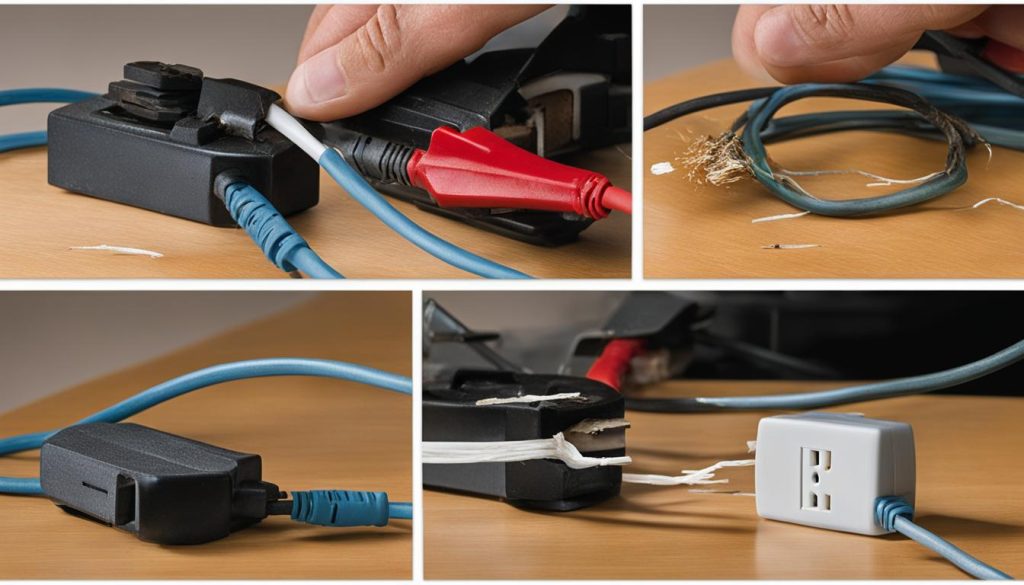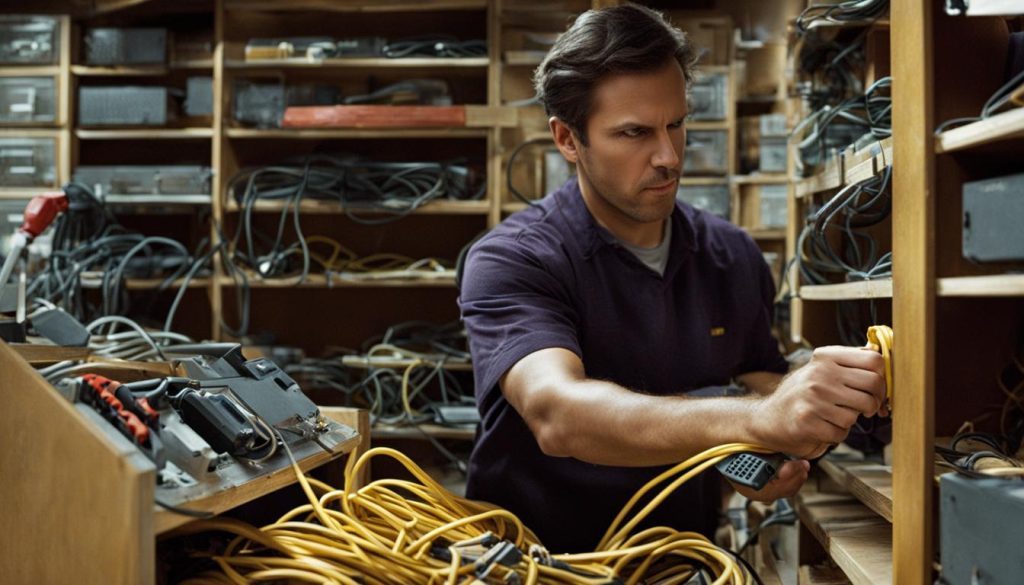Extension cords are a common tool for delivering electricity to inaccessible areas, but it’s important to prioritize safety when using them. Regular inspections of your extension cords are crucial to ensure their proper functioning and prevent potential hazards. In this article, we’ll discuss how often you should inspect your extension cords and provide recommendations for maintaining their safety.
Key Takeaways:
- Regularly inspect your extension cords for signs of damage or wear to prevent fire hazards and electrical shocks.
- The frequency of inspections depends on factors such as cord length, usage, and condition.
- Follow Occupational Safety and Health Administration (OSHA) and National Electric Code guidelines for extension cord inspection and maintenance.
- Factors such as environmental conditions, usage, and cord gauge can affect the lifespan of your extension cords.
- If you notice any signs of damage, such as cracks, melting, or exposed wires, replace the cord immediately.
Factors Affecting Extension Cord Lifespan
The lifespan of an extension cord can be influenced by several factors. Let’s explore the average lifespan of extension cords and the factors that can affect their durability.
Environmental Conditions
Exposure to extreme weather conditions, such as heat, cold, or moisture, can accelerate the deterioration of an extension cord’s wiring. Constant exposure to these elements can weaken the cord’s insulation and lead to potential hazards.
Frequency of Use and Load
The lifespan of an extension cord can also be affected by how frequently it is used and the amount of load it carries. If a cord is constantly in use or subjected to heavy loads, it may experience more wear and tear compared to a cord used for lighter-duty applications or rarely used.
Exterior Damage
Regularly checking the cord for signs of exterior damage is essential. Look out for nicks, cracks, or frays in the cord’s protective coating. Any compromise in the outer insulation can expose the internal wires, presenting a potential electrical hazard.
Cord Gauge
The gauge of the cord refers to its thickness. Lower gauge cords are thicker and more resistant to wear and tear, making them generally more durable. Higher gauge cords, on the other hand, may be more prone to damage and have a shorter lifespan.
By understanding these factors, you can take the necessary steps to ensure the longevity and safety of your extension cords. Regularly inspecting them and addressing any issues promptly can help prevent accidents and maintain electrical safety.
Importance of Extension Cord Inspections
Regularly inspecting extension cords is crucial for maintaining electrical safety. Faulty extension cords can pose serious risks, including house fires and electrical shocks. The National Fire Protection Association reports that faulty extension cords are responsible for an average of 2,900 house fires every year in the United States.
Inspecting extension cords helps identify any signs of damage or wear that could lead to accidents. By taking the time to inspect your extension cords, you can ensure that all electrical devices are working properly and that the cords are in good condition.
The Risks of Not Inspecting Extension Cords
Not inspecting extension cords can have severe consequences. Damaged cords may lead to electrical fires, which can cause extensive property damage and put lives at risk. Electrical shocks from faulty extension cords can result in injuries ranging from minor burns to severe electrocutions.
“Faulty extension cords are responsible for an average of 2,900 house fires every year in the United States.”
Regular inspections help identify potential hazards and allow for prompt repairs or replacements, minimizing the risk of accidents. It is essential to prioritize the safety of yourself, your family, and your property by routinely inspecting extension cords.
Inspecting extension cords is a straightforward process that can greatly enhance safety. By looking for visible signs of damage, such as frayed wires or cracked insulation, you can identify potential issues before they escalate. Regular inspections should be a standard practice to ensure the integrity of your extension cords and to mitigate the risks associated with faulty electrical connections.
- Regular inspections reduce the chances of electrical fires.
- Identifying damage early prevents accidents and injuries.
- Ensuring extension cords are in good condition enhances overall electrical safety.
By promoting vigilance in inspecting extension cords, you can create a safer environment for everyone.
Signs of a Damaged Extension Cord
When inspecting an extension cord for damage, it is important to be aware of the signs that indicate potential hazards. By identifying these signs early on, you can take the necessary steps to prevent accidents and ensure electrical safety. Here are some key indicators that a cord may be damaged:
- Mismatched wiring colors: Extension cords typically have black wires for hot, white wires for neutral, and green wires for ground. If the colors of the wires inside the cord do not align with their respective labels on the outside, it could be a sign of tampering or damage. In such cases, it is advisable to replace the cord immediately to avoid potential risks.
- Cracks, melting, or exposed wires: Physical damage to the cord, such as cracks, melting, or exposed wires, is a clear indication that the cord is compromised. These issues can lead to electrical shocks or even house fires. If you notice any of these signs, it is crucial to dispose of the cord and replace it with a new one.
- Inspecting the entire cord: To ensure a thorough examination, visually inspect the entire length of the cord. Pay close attention to the plug, cord insulation, and electrical connections at both ends. Look for any physical damage, loose parts, or signs of wear and tear. This comprehensive inspection will help identify any hidden issues that may pose a risk.
Regularly checking for these signs of damage is essential for maintaining the safety of your extension cords. By taking proactive measures, you can prevent accidents and ensure the longevity of your electrical equipment.

Tips for Inspecting and Maintaining Extension Cords
When it comes to extension cords, regular inspections and maintenance are essential for ensuring safety and preventing potential hazards. By following these tips, you can effectively inspect and maintain your extension cords, keeping them in good condition and minimizing the risk of accidents.
1. Check the Plug
Start by examining the plug of your extension cord. Look for any signs of bending, burning, or damage. Additionally, inspect the plug prongs and socket holes for any harm, ensuring they are intact and without any cracks. A damaged plug can result in poor electrical connection or even dangerous short circuits.
2. Inspect the Cord
Next, visually inspect the entire length of the cord for any signs of damage, cuts, or holes in the outer casing. Pay close attention to areas where the cord is bent or twisted, as these are vulnerable to wear and tear. If you come across any exposed wires, moisture, or dirt, take immediate action to address the issue.
3. Determine Inspection Frequency
The frequency of inspecting your extension cords depends on their location and usage. Outdoor extension cords should be inspected at least once a year, as they are exposed to harsh weather conditions and environmental factors. On the other hand, indoor extension cords should be inspected every three months to ensure their continuous safety and functionality.
4. Avoid Overnight Use
As a precautionary measure, it is advisable not to leave extension cords plugged in overnight. Unplugging them when not in use can reduce the risk of overheating, electrical shocks, and potential fire hazards. It is always better to prioritize safety and minimize the chances of accidents.
By following these simple yet effective tips, you can keep your extension cords in optimal condition and ensure the safety of yourself and those around you. Remember, regular inspections and maintenance are crucial for your peace of mind and a secure electrical environment.

| Type of Cord | Inspection Frequency |
|---|---|
| Outdoor Extension Cords | At least once a year |
| Indoor Extension Cords | Every three months |
Best Practices for Extension Cord Usage
Ensuring the safe and optimal use of extension cords requires following a set of best practices and safety guidelines. By implementing these practices, you can mitigate potential risks and protect yourself and others from hazards.
Firstly, it is important to use extension cords strictly for temporary purposes and not as a permanent solution. According to OSHA standards, extension cords should not be used for more than 90 days. This prevents wear and tear from prolonged use, reducing the risk of electrical hazards.
Matching the thickness of the extension cord to the power requirements of the connected tool or device is another important practice. Overloading the circuit can lead to overheating and fires. By using the right gauge extension cord, you can ensure the safe and efficient delivery of electricity.
When using extension cords in wet or damp environments, it is crucial to utilize Ground Fault Circuit Interrupter (GFCI) protection. GFCI devices are designed to quickly detect electrical faults and cut off power, preventing electric shocks and potential electrocutions.
Additional safety measures include keeping extension cords away from water, children, and animals, and always unplugging them when not in use. Avoid running cords through doorways, holes, or areas where they may be damaged. For added protection, consider using cord protectors and adding more electrical outlets to minimize the reliance on extension cords.
FAQ
How often should you inspect an extension cord?
It is recommended to inspect extension cords before each use to ensure their safety. Additionally, outdoor extension cords should be inspected at least once a year, while indoor extension cords should be inspected every three months.
What factors affect the lifespan of an extension cord?
The lifespan of an extension cord can be influenced by factors such as usage, environmental conditions, and the gauge of the cord. Frequent usage and exposure to extreme weather or moisture can shorten the lifespan, while lower gauge cords tend to be more durable.
Why is it important to inspect extension cords?
Regular inspection of extension cords is crucial for maintaining electrical safety. Faulty cords can pose serious risks, including house fires and electrical shocks. By inspecting the cords, potential signs of damage or wear can be identified and addressed to prevent accidents.
What are the signs of a damaged extension cord?
Signs of a damaged extension cord include cracks, melting, exposed wires, and any inconsistencies between the color-coding inside and outside the cord. Additionally, visually inspect the entire length of the cord, including the plug, insulation, and electrical connections, for any physical damage or loose parts.
How do I inspect and maintain extension cords?
When inspecting an extension cord, check the plug for any bending, burning, or damage, and ensure there is no damage around the prongs and socket holes. Visually inspect the entire cord for any damage, cuts, or holes in the outer casing. Make sure there are no exposed wires, moisture, or dirt. Regular cleaning and proper storage can also help maintain the condition of extension cords.
What are the best practices for using extension cords?
To ensure safe and optimal use, extension cords should be used for temporary purposes and not as a permanent solution. They should be matched in thickness to the tool or device being powered to avoid overloading the circuit. Ground fault circuit interrupter (GFCI) protection should be used in wet or damp environments. Keep extension cords away from water, children, and animals, and unplug them when not in use. Avoid running cords through doorways, holes, or areas where they may be damaged. Adding additional electrical outlets or using cord protectors can also help reduce hazards.


